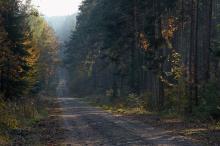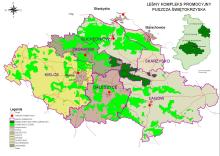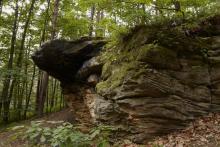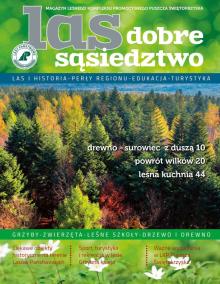 Asset Publisher
Asset Publisher
Polish forests
Poland is in the European lead, while concerning the area of all forests. They cover about 29,2 % of the country territory, and grow within the area of 9,1 million hectares. The overwhelming majority of the forests is state owned, of which almost 7,6 million hectares are managed by the State Forests National Forest Holding..
The number of Polish forest is still growing. The forestation rate of the country has increased from 21 % in 1945 to 29,2 % at the moment. Between 1995 and 2008, the forest area increased by 310 thousand ha. The basis for afforestation works is the "National Programme for Increasing the Forest Cover" (KPZL), assuming an increase of the forestation rate up to 30 % by 2020 and up to 33 % by 2050. Polish forests abound in flora, fauna and fungi. 65 % of the total number of animal species live there.
The forests grow in our country on poor soils, mainly because of the development of the agriculture in previous years. It influences the distribution of the types of the forest sites in Poland. Over 55 % of the forest areas is covered with coniferous forests. In other areas, there are forest sites, mainly the mixed ones. Their small part constitute alder and riparian forests – not more than 3 %.
In the years 1945 – 2011 the area of natural deciduous tree stands within the area of the State Forests National Forest Holding increased from 13 to 28,2 %.
Within the lowlands and uplands the most often occurring tee species is pine. It covers 64,3 % of the forest area of the State Forests National Forest Holding and 57,7 % of private and commune forests. In the mountains the predominant species is European spruce ( in the west) and European spruce with beech (in the east). Domination of pine is the result of carrying on sustainable forest management in the past. Once, the monocultures (crops or cultivations of one species) were the answer to the great demand of industry for wood. Such forests appeared to be quite fragile to climatic factors. They also were often the prey of pests' expansion.
In Polish forests, the share of other tree species, especially deciduous trees have been systematically increasing. The foresters have stepped aside from monocultures – that is why, they try to fit specific species of the forest stand to the natural stand, that would be proper for the given area. Thanks to that, in the years 1945 – 2011, the area of the deciduous tree stands within the lands of the State Forests National Forest Holding increased from 13 to 28,2 %. There occur more and more frequently the following tree species: oaks, ashes, maples, sycamore maples, elms, but also birches, beeches, alders, poplars, hornbeams, aspens, tilias and willows.
Our forests are the most often represented by the forest stands aged 40 to 80 years. The average age of the forest equals 60 years. More and more trees are of big size at the age over 80 years. Since the end of the Second World War, the forests' area has increased up to almost 1,85 million hectares.
Raport o stanie lasów w Polsce 2012
 Asset Publisher
Asset Publisher
Usłysz, co w lesie huczy. Leśnicy zapraszają na sowią noc
Usłysz, co w lesie huczy. Leśnicy zapraszają na sowią noc
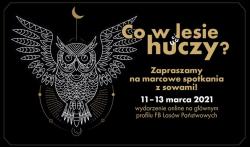
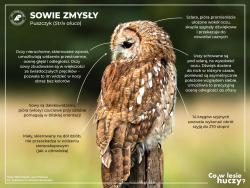 Infografika Sowie zmysły, Centrum Informacyjne Lasów Państwowych
Infografika Sowie zmysły, Centrum Informacyjne Lasów Państwowych
 Infografika Włoski czuciowe u sów, Centrum Informacyjne Lasów Państwowych
Infografika Włoski czuciowe u sów, Centrum Informacyjne Lasów Państwowych

Niecodzienne wydarzenie dla miłośników sów oraz dzikiej przyrody organizują Lasy Państwowe. Już w połowie marca będzie można usłyszeć „co w lesie huczy”. W organizacji wydarzenia nie przeszkodziła leśnikom nawet pandemia, gdyż większość atrakcji odbędzie się online.
Dlaczego teraz jest organizowane wydarzenie „Cowlesiehuczy”? Koniec zimy to czas, kiedy w lesie do głosu dochodzą sowy. U większości z nich na przełomie lutego i marca trwa okres godowy. Samce głośno pohukując nawołują samice na swoje terytorium.
- Chcemy przybliżyć wiedzę na temat tych wyjątkowych ptaków, ale i pokazać, że po zmroku, las może być równie atrakcyjny, jak za dnia - mówi Andrzej Konieczny, dyrektor generalny Lasów Państwowych. - Mimo pandemii każdy może wziąć w niej udział, ponieważ wszystkie atrakcje odbędą się online na profilu Lasów Państwowych na Facebooku.
Ze względu na panujące obostrzenia leśnicy postanowili znaleźć rozwiązanie, by spotkać się z miłośnikami sów i przyrodniczych ciekawostek.
W tym roku każdy może wziąć udział w tym wydarzeniu, ponieważ wszystkie atrakcje zostaną przeniesione do wirtualnego świata.
Infografiki do "Cowlesiehuczy"Na wydarzenie Lasy Państwowe zapraszają każdego, komu sowy już skradły serce i każdego, kto chciałby je poznać bliżej.
W czasie trzydniowego wydarzenia online (11 a 13 marca), na głównym profilu Lasów Państwowych na uczestników będzie czekało mnóstwo atrakcji.
W programie zaplanowano m. in.:
- Sowią lekcję online z edukatorami leśnymi, w której będziecie mogli wziąć udział w domu lub w klasie z uczniami
- Filmy pełne ciekawostek, faktów i mitów, po których już nikt nie będzie miał wątpliwości, czym jest wypluwka, do czego służy sowom szlara i co sprawia, że lot sów jest taki bezszelestny
- Rozmowy z ekspertami, przyrodnikami, sowiarzami, czyli tymi, przed którymi sowy nie mają tajemnic
- Wizyta w ośrodku rehabilitacyjnym dla ptaków drapieżnych, gdzie porozmawiamy ze specjalistami o tym, jak wygląda opieka nad pacjentami
- Nocna wyprawa do lasu i słuchanie głosów sów. Sowie pieśni miłosne najczęściej słychać po zmierzchu lub późnym wieczorem, to właśnie wtedy warto wybrać się do lasu. Tak! Będzie można je usłyszeć na własne uszy!
- W końcu razem z leśnikami, na żywo, będzie można obejrzeć moment zwrócenia naturze sów, które zostały wyleczone w ośrodku, a teraz mogę wrócić do lasu.

Pokażemy Wam na żywo puszczyki, uszatki, a nawet puchacza! Dodatkowo leśnicy powiedzą, czy możemy zbierać sowie pióra w lesie, co zrobić, jeśli znajdziemy młodą sowę pod drzewem i jak samodzielnie je nasłuchiwać, tak by było to bezpieczne dla ludzi i dla ptaków.
To nie wszystko! Do końca marca w różnych nadleśnictwach w Polsce będą przygotowane sowie atrakcje, czyli nocne wyprawy do lasu czy zajęcia online.
By być na bieżąco z atrakcjami wystarczy śledzić profil główny Lasów Państwowych oraz strony nadleśnictw, które przygotowały sowie niespodzianki.
Na specjalnie przygotowanej mapie, która już wkrótce zostanie opublikowana, będzie można znaleźć miejsca, gdzie szykują się dodatkowe atrakcje.
Dodatkowe materiały:


 fot. Paweł Fabijański
fot. Paweł Fabijański
 fot. Paweł Fabijański
fot. Paweł Fabijański
 fot. Paweł Fabijański
fot. Paweł Fabijański

